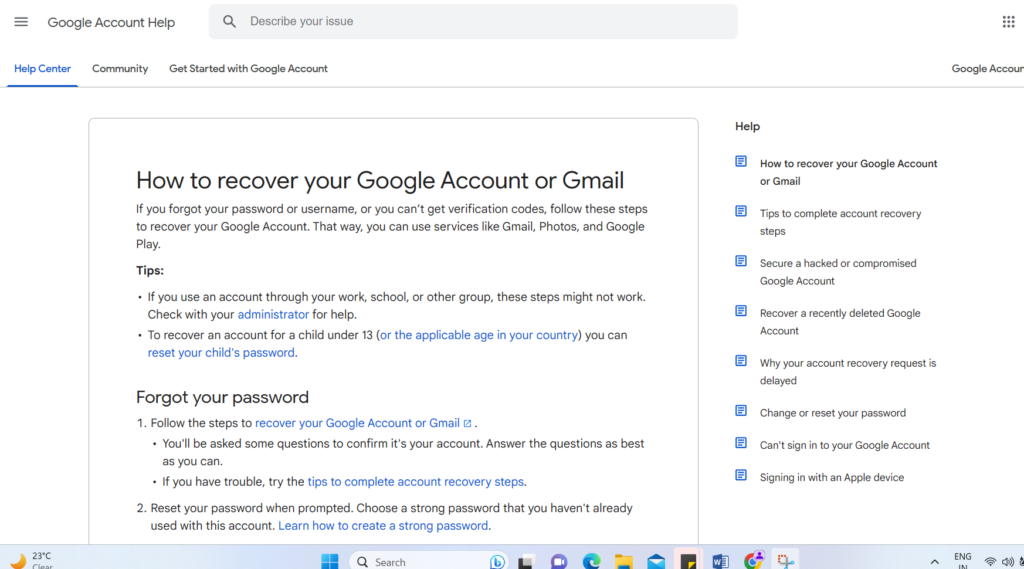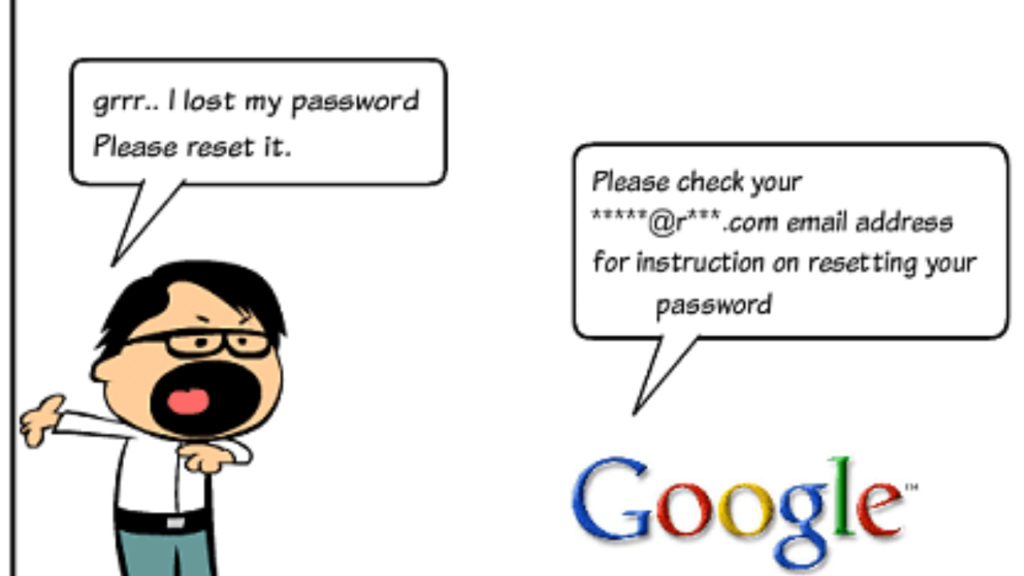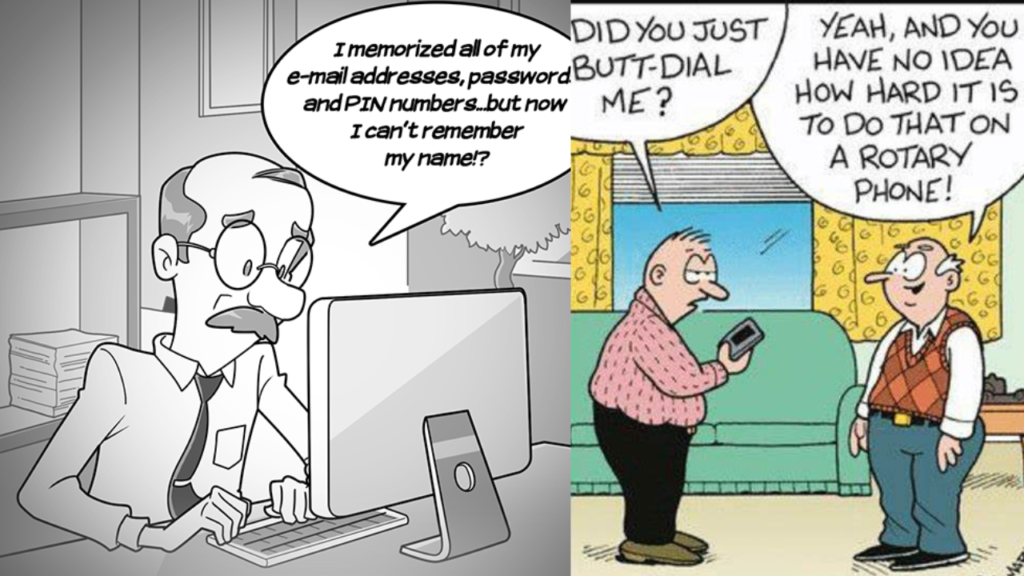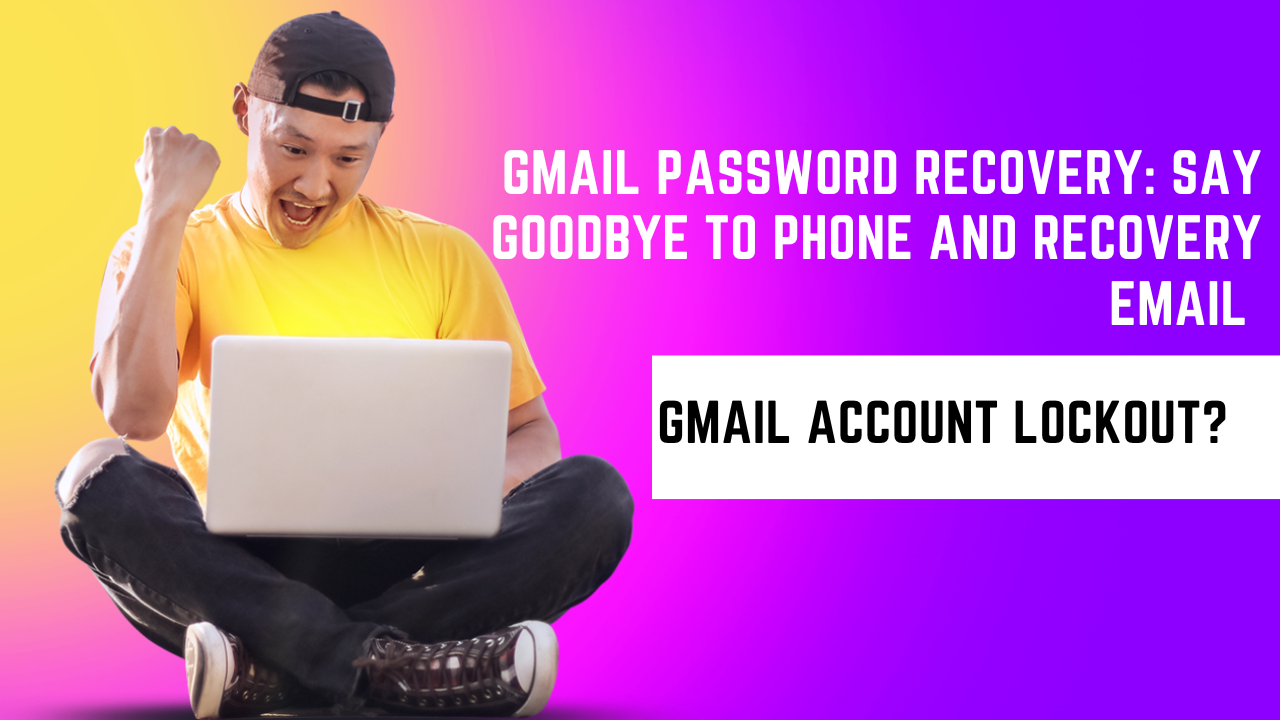Table of Contents
1. Understanding the Importance of Account Recovery:
In the vast landscape of our digital interactions, Gmail accounts hold a pivotal role as gateways to our online identities. These accounts are not mere email addresses; they encapsulate our communication, personal data, and access to various online services. Think of them as the digital keys to your virtual kingdom. They allow us to stay connected with friends, family, and colleagues, and even conduct important business affairs. Furthermore, Gmail accounts are often linked to various online platforms, ranging from social media to cloud storage services, amplifying their significance in our lives.
Example: Imagine this scenario: You’ve relied on your Gmail account for years to stay in touch with friends and manage crucial work communications. Suddenly, you find yourself locked out due to a forgotten password, leaving you cut off from your important messages and documents. This illustrates the vital role Gmail accounts play in our day-to-day activities and the urgency of recovering access when unforeseen circumstances arise.

Key Points:
- Gmail accounts serve as central hubs for our digital presence.
- They store communication history, personal data, and access to various online services.
- Linked to social media and cloud storage, Gmail accounts are integral to our online identity.
Briefly explain the significance of Gmail accounts in our digital lives:
Our digital era has transformed the way we communicate, work, and engage with the world. Amid this transformation, Gmail accounts have emerged as essential anchors that connect us to this digital realm. These accounts encapsulate our conversations, professional interactions, and even hold the key to our online financial transactions. They act as the digital backbone of our modern lives, streamlining communication and fostering collaboration across the globe.
Example: Picture a freelance graphic designer who relies on their Gmail account to receive project briefs, collaborate with clients, and send design drafts. This account serves as a virtual workspace where ideas flow, creative endeavors take shape, and livelihoods are sustained. Losing access to such an account would not only disrupt the designer’s workflow but also impact their professional reputation and income.
Key Points:
- Gmail accounts are essential for communication and collaboration.
- They play a crucial role in professional interactions and business transactions.
- Modern life is intricately linked to Gmail accounts, making their recovery paramount.
Highlight the reasons for the need to recover accounts – forgotten passwords, lost phone numbers, etc.:
The need for account recovery becomes apparent when unforeseen circumstances disrupt our access. Forgotten passwords, misplaced recovery information, and lost phone numbers are some of the common scenarios that warrant account recovery. As we become more reliant on our digital identities, these accounts become integral to both personal and professional aspects of our lives, emphasizing the urgency of swift recovery methods.
Example: Consider someone who diligently maintained their Gmail account but accidentally reset their phone without backing up their data. In this situation, the loss of the recovery information stored on the device’s SIM card means they can’t receive verification codes, hindering their access. Similarly, an individual who hasn’t logged into their account for an extended period might forget their password, underscoring the need for secure recovery processes.
There are various circumstances that can lead to the need for account recovery. Some common scenarios include:
- Forgotten Passwords: It’s easy to overlook passwords, especially if you have multiple accounts. Without the correct password, accessing your Gmail becomes impossible.
- Lost or Changed Phone Numbers: If you’ve changed your phone number or lost access to it, you might not receive verification codes or account recovery information.
- Unauthorized Access: If your account is compromised, regaining control is paramount to prevent misuse.
- Access Across Devices: Switching devices or using new ones requires account login, and not having the right credentials can pose challenges.
Example: Consider someone who uses Gmail primarily on a laptop. If their laptop gets stolen, they might face issues accessing their account from a new device due to the forgotten password or a lack of the previous laptop.
In the digital era, Gmail account recovery ensures that you maintain your online presence and safeguard your sensitive information.
2. Accessing the Account Recovery Page:
Gaining access to Gmail’s Account Recovery page is a straightforward process that can be completed with a few simple steps. Here’s how you can do it:
- Open Your Web Browser: Launch your preferred web browser on your computer or mobile device.
- Go to Gmail: In the address bar, type “www.gmail.com” and press Enter.
- Click “Need help?” Link: On the Gmail login page, click on the “Need help?” link located just below the “Next” button.
- Choose “Forgot password?”: You’ll be directed to a new page with different account recovery options. Choose the “Forgot password?” option.
- Enter Your Email Address: Input the Gmail email address for which you’ve forgotten the password and click “Next.”
- Verification Method: Depending on your account’s setup, you might be prompted to enter the last password you remember or use another verification method. Follow the on-screen instructions.
- Access Recovery Page: Once you’ve successfully verified your identity, you’ll be taken to the Account Recovery page. Here, you can reset your password and regain access to your Gmail account.
Emphasize the user-friendly interface designed to simplify the recovery process:
Gmail’s Account Recovery page has been designed with user convenience in mind. Its intuitive layout and step-by-step instructions ensure that even users who are not tech-savvy can navigate through the process smoothly. The straightforward prompts guide you through each stage, making it easier to verify your identity and regain access to your account. Gmail’s commitment to user experience shines through in this interface, minimizing stress and frustration during the account recovery journey. This user-friendly approach is aimed at providing a seamless and efficient experience, ensuring that you’re back to your emails and online activities in no time.

Example: Imagine Emma, who’s a recent college graduate, encounters trouble accessing her Gmail after changing her phone number. Feeling uncertain about what to do, she follows the steps outlined on the Account Recovery page. The instructions are straightforward, and the option to use her recovery email instead of her old phone number puts her at ease. The clear layout and straightforward instructions guide her through the process, allowing her to successfully regain access to her account.
3. Forgot Your Password? No Worries!
Walkthrough of the password recovery process: If you’ve found yourself locked out of your Gmail account due to a forgotten password, worry not! Gmail offers a straightforward password recovery process to help you regain access:
- Access the Account Recovery Page: Follow the steps outlined earlier to reach the Account Recovery page.
- Select “Forgot password?”: Click on this option to initiate the password recovery process.
- Enter Your Email Address: Provide the Gmail address associated with your account.
- Choose Recovery Option: If you’ve set up a recovery email address during account creation, you’ll be presented with the option to receive a password reset link on that email.
- Check Your Recovery Email: Open the recovery email inbox and look for the password reset email from Google.
- Click the Reset Link: Click on the link provided in the email. This link will take you to a page where you can create a new password for your Gmail account.
- Create a New Password: Craft a strong and secure password that combines letters, numbers, and symbols to enhance your account’s protection.
- Confirm the New Password: Retype the new password to ensure accuracy.
- Login with New Password: Return to the Gmail login page and use your newly set password to access your account.
Mention the option to receive a password reset link on your recovery email:
A valuable aspect of Gmail’s password recovery process is the option to receive a password reset link on your recovery email. This method offers convenience and security, allowing you to reset your password without the need for a phone number or verification code. The password reset link ensures a direct and efficient route to regaining account access.
Suggest the importance of strong, memorable passwords to prevent future issues:
While recovering your password is possible, it’s equally important to ensure your Gmail account’s long-term security. Opt for passwords that are not only strong but also memorable to you. A strong password typically includes a combination of upper and lower-case letters, numbers, and special characters. Avoid using easily guessable information such as birthdates or common words. Strengthening your password helps thwart unauthorized access attempts, ensuring the safety of your emails, documents, and personal information.
Example: Sarah, an avid traveler, had trouble accessing her Gmail after returning from a trip. Following the password recovery steps, she opted for the password reset link to be sent to her recovery email. This method proved efficient, and she was able to reset her password and regain access swiftly. Understanding the importance of strong passwords, Sarah ensures her new password is a combination of her favorite travel destinations and meaningful numbers, significantly enhancing her account’s security.
Lost Phone Number and Verification Code? You Still Have Options:
Losing access to your phone number and verification code doesn’t have to be a roadblock in regaining control of your Gmail account. In the dynamic landscape of account recovery, Gmail offers alternative pathways to restore your access and ensure you’re connected to your digital world. Here are some avenues to explore:

1. Recovery Email Address: If you’ve associated a recovery email address with your Gmail account, you’re in luck. This designated email acts as a bridge between you and account recovery. When faced with a lost phone number, you can opt to receive account recovery instructions through this recovery email. It’s a reliable method that provides a seamless route to regaining access without relying on a phone number.
2. Security Questions: Remember those security questions you set up when you created your Gmail account? They’re not just for show – they’re a powerful tool for account recovery. These personalized questions are designed to be known only to you. When conventional methods falter, providing accurate answers to your security questions can prove your identity and grant you access to your account once again.
3. Account Recovery Form: Gmail’s Account Recovery Form is a versatile solution designed to accommodate various recovery scenarios. This form allows you to provide additional information about your account, such as the date of account creation, frequently contacted email addresses, and more. Google’s algorithms scrutinize this data to verify your identity and ensure that you, the rightful owner, regain access.
Example: Alex, a freelance designer, faced a setback when his phone was stolen along with his number. Feeling helpless, he remembered linking a recovery email to his Gmail account. Utilizing this option, he received the necessary recovery instructions and successfully reset his password. Moreover, he managed to answer his security questions accurately, underscoring their importance as a failsafe method.
In the face of lost phone numbers and vanished verification codes, remember that Gmail has your back. These alternative recovery methods provide a safety net, ensuring that you remain connected to your Gmail account and the digital landscape it encompasses.
Exploring Alternative Methods for Recovery: Leveraging Recovery Email Address
When traditional recovery avenues like phone numbers and verification codes are no longer accessible, there’s no need to panic. Gmail offers a lifeline through alternative methods, and one such method is utilizing a recovery email address. Here’s how this approach can save the day:
The Role of Recovery Email Address: A recovery email address acts as a guardian angel for account access. It’s the email you’ve designated during account creation to serve as a backup in case of emergencies. When faced with a lost phone number or verification code, this recovery email comes to the rescue.
How It Works:
- Access the Account Recovery Page: Visit the Gmail login page and click on “Forgot email?” or “Forgot password?” as appropriate.
- Enter Your Email Address: Provide your Gmail address and proceed.
- Choose Recovery Email Option: When prompted to recover via email, select this option.
- Check Your Recovery Email Inbox: Open your designated recovery email inbox. You’ll find a message from Google containing account recovery instructions.
- Follow the Instructions: Click on the provided link to set a new password for your Gmail account.
The Advantages:
- No Phone Number Dependency: The recovery email method liberates you from the need for a functional phone number. This is especially handy when you’ve changed your number or it’s no longer accessible.
- Secure and Effective: Recovery emails provide a secure means of regaining access. As long as you have access to your recovery email, you can reset your password and regain control of your account.
Ensuring Success: To make the most of this method, ensure your recovery email address is up to date and accessible. Additionally, treat your recovery email’s security with the same importance as your primary email. Regularly check its inbox and keep its credentials safe.
Example: Imagine Ava, a photography enthusiast, faced an access roadblock after her phone was misplaced. With her recovery email in place, Ava received recovery instructions and was able to set a new password. This method allowed her to bypass the need for a phone number, showcasing the effectiveness of alternative recovery methods.
In the realm of account recovery, a recovery email address is a beacon of hope. It ensures that even without a phone number, your access to your Gmail account remains within reach.
The Power of Security Questions:
Delving into the Significance of Security Questions: Security questions are the sentinels that guard your account’s gateways, acting as a bridge between you and account recovery. When employed effectively, they offer an extra layer of protection against unauthorized access and ensure a personalized route to account restoration. These queries are pivotal in verifying your identity during recovery attempts, ensuring that you and only you regain access to your Gmail account.
Advice on Selecting Questions that are Hard to Guess and Easy to Remember: When selecting security questions, strategic choice is paramount. Opt for questions that blend a touch of complexity with your personal history. Questions that are too generic can be guessed or researched, so prioritize those that are known only to you. For example, instead of “What’s your favorite color?” consider a question like “What was the name of your first pet?” Such questions often provide answers that are meaningful to you but challenging for others to guess.
The Importance of Keeping Answers Secure and Private: As the guardians of your account, security questions demand secrecy. Just as you would safeguard your password, ensure that the answers to your security questions remain known only to you. Avoid sharing them with anyone and refrain from using easily accessible information like birthdates or common words. Remember, the strength of security questions lies in their exclusivity.
Example: Meet Mia, a music enthusiast who encountered a challenge when her phone number changed. By effectively leveraging security questions during her Gmail account setup, Mia could answer questions like “What’s your favorite song?” and “Where did you go on your first vacation?” These answers are unique to her experiences, making them a secure and reliable means of verification.
Security questions aren’t just arbitrary queries; they’re the keys to unlocking your account’s treasure trove. By selecting wisely, you build a fortress against unauthorized access, ensuring that the path to account recovery remains a private journey.
Leveraging the Account Recovery Form:
Understanding the Role of the Account Recovery Form as a Backup Option: The Account Recovery Form is akin to a safety net, a sanctuary of solutions when traditional recovery methods prove elusive. Designed as a versatile backup, it steps in to offer a lifeline in scenarios where access to phone numbers, recovery emails, or security question answers is compromised. This form serves as a comprehensive avenue, weaving together vital account details to establish your identity and grant access to your Gmail account.
Tips for Accurate Form Submission and Enhanced Success:
Filling out the Account Recovery Form requires precision and attention to detail. To maximize your chances of success, consider the following tips:
- Provide Comprehensive Information: Share as much relevant information as possible. Include details like the approximate date you created the account, frequently contacted email addresses, and recent login locations. The more comprehensive your submission, the stronger the case you build for your identity.
- Be Precise and Accurate: Ensure the information you provide is accurate and matches the account history. Any inconsistencies can hinder the verification process.
- Double-Check Your Answers: Before submitting the form, review your answers. Make sure they are clear, concise, and relevant to the questions asked.
Highlighting Google’s Commitment to Account Security:
Google’s commitment to account security is mirrored in the Account Recovery Form’s careful scrutiny of submitted information. This meticulous review process underscores Google’s dedication to ensuring that only the rightful account owner gains access. By meticulously examining the provided data, Google reinforces its pledge to maintain the integrity of the recovery process and prevent unauthorized access.
Example: Consider Ben, an adventure enthusiast whose phone was stolen during a hiking trip. With no access to recovery methods, he turned to the Account Recovery Form. By diligently completing the form and providing precise information about his account creation date and frequently contacted addresses, he navigated the path of account recovery successfully.
The Account Recovery Form isn’t just a form; it’s a testament to Google’s dedication to account security. Its role as a backup, coupled with accurate information submission, serves as a bridge to restoring access, and its thorough review process stands as a testament to Google’s commitment to protecting your digital identity.
Reaching Out to the Support Team:
When All Else Fails: The Support Team as a Last Resort
Reaching out to Google’s support team should be your last step after exhausting all other account recovery options. While they can offer assistance, it’s important to remember that they handle a significant volume of requests and may require more time to respond. Consider this option only when self-help methods and alternative recovery avenues have been thoroughly explored.
Insights into Google’s Support Team Assistance:
Google’s dedicated support team is equipped with the expertise to navigate complex account recovery scenarios. Upon contacting them, they will guide you through a series of steps to verify your identity and regain access to your Gmail account. This verification process might involve providing details about your account’s history, security settings, and any other pertinent information.
Patience is Key: Navigating the Path to Resolution
It’s crucial to approach communication with Google’s support team with patience and understanding. Due to the volume of requests they handle, response times can vary. Recognize that their primary goal is to ensure the utmost security of your account, which necessitates careful verification of your identity and information. Patience during this process is a vital factor in achieving a successful outcome.
Example: Imagine Mark, an IT professional, encountered a unique situation where both his recovery email and security questions were inaccessible. Despite his initial frustration, he reached out to Google’s support team as a last resort. The support team carefully guided him through the process, verifying his identity through a detailed conversation. Mark’s patience during the communication allowed him to successfully regain access to his Gmail account, demonstrating the importance of perseverance when dealing with support interactions.
While the support team can be a valuable resource, it’s imperative to approach this option with a realistic understanding of its role and limitations. By considering it as a final recourse, remaining patient throughout the communication, and providing accurate information, you enhance your chances of navigating the path to account recovery successfully.
Staying Prepared: Practical Tips and Takeaways:
Summarizing Key Points for Successful Account Recovery:
- Explore Alternative Methods: When faced with lost phone numbers or verification codes, remember that there are alternative avenues like recovery email addresses, security questions, and the Account Recovery Form.
- Select Secure Security Questions: Choose security questions that are difficult for others to guess but easy for you to remember. Opt for questions related to your personal experiences rather than generic ones.
- Fill Out the Account Recovery Form Accurately: If all else fails, the Account Recovery Form can be your backup. Provide comprehensive, precise, and truthful information for a higher chance of success.
- Contact Support Team as a Last Resort: Reaching out to Google’s support team should be considered a last resort. They handle numerous requests, so patience and persistence are key during communication.

Actionable Tips for Maintaining Account Security:
- Regularly Update Recovery Information: Keep your recovery email, phone number, and security questions up to date. This ensures that you have reliable options for account recovery.
- Use Strong, Unique Passwords: Craft strong passwords for your accounts, combining letters, numbers, and symbols. Avoid common words or easily guessable information.
- Enable Two-Factor Authentication (2FA): Implement 2FA for an additional layer of security. This adds a verification step beyond passwords.
- Secure Your Recovery Email: Treat your recovery email’s security with the same importance as your primary email. Regularly check its inbox and protect its credentials.
- Stay Vigilant Against Phishing: Be cautious of phishing attempts that aim to extract your account information. Double-check URLs and only enter your credentials on official sites.
- Educate Yourself: Familiarize yourself with the account recovery process and options available. This knowledge can be invaluable in times of crisis.
Example: Emily, a tech-savvy individual, took the lessons learned from her account recovery journey to heart. She regularly updated her recovery information, used strong passwords, and enabled 2FA for an added layer of protection. Her vigilance against phishing attempts and her understanding of the recovery process ensured the security of her accounts.
By adhering to these tips and incorporating the lessons from successful account recovery, you not only safeguard your Gmail account but also equip yourself to handle any future challenges that may arise.
Conclusion: Navigating the Path to Gmail Account Recovery
In the ever-evolving landscape of digital connectivity, the significance of Gmail accounts in our lives cannot be overstated. However, the inevitable challenges of forgotten passwords, lost phone numbers, and inaccessible verification codes can cast a shadow over our online experiences. The journey to account recovery, once a daunting expedition, is now paved with alternative avenues and robust tools, ensuring that access to our Gmail accounts remains within our grasp.
From the strategic use of recovery email addresses to the resilience of security questions, and from the comprehensive Account Recovery Form to the potential assistance of the support team, the arsenal of recovery options is both diverse and empowering. By selecting personalized security questions that are hard to guess and easy to remember, we fortify our accounts against unauthorized access. Filling out the Account Recovery Form with precision and patience showcases Google’s commitment to account security and the protection of our digital identities.
Staying prepared becomes the cornerstone of successful account management. By consistently updating recovery information, embracing strong passwords and two-factor authentication, securing recovery emails, and remaining vigilant against phishing attempts, we construct layers of defense that deter potential breaches. Armed with knowledge about the recovery process and a prudent approach to security, we emerge as digital custodians, safeguarding our Gmail accounts against the unpredictability of the virtual realm.
As we tread the path to account recovery, let us remember that the key to success lies not only in regaining access but also in proactively preserving our digital sovereignty. By embodying the lessons learned from successful recovery journeys, we navigate the complexities of our Gmail accounts with confidence, ensuring that the essence of our digital existence remains intact.



